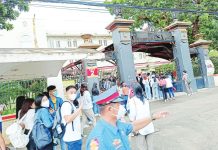[av_one_full first min_height=” vertical_alignment=” space=” custom_margin=” margin=’0px’ padding=’0px’ border=” border_color=” radius=’0px’ background_color=” src=” background_position=’top left’ background_repeat=’no-repeat’ animation=”]
[av_heading heading=’ NO FILTER ‘ tag=’h3′ style=’blockquote modern-quote’ size=” subheading_active=’subheading_below’ subheading_size=’15’ padding=’10’ color=” custom_font=”]
BY RHICK LARS VLADIMER ALBAY
[/av_heading]
[av_textblock size=” font_color=” color=”]
ON THURSDAY, the evening of the 45th anniversary of the late dictator Ferdinand Marcos’ martial law declaration and what was decreed a “national day of protest” by no other than President Rodrigo Duterte himself, we attended “Lost Lines” an event spearheaded by “modern heroism” group Dakila at the Molo Plaza.
The event was part public installation piece, part poetry night: With the group setting up a yellow police tape to surround the small venue, at the center of which was a chalk outline of a small child – not too far from what we’d imagine the scenes where in the aftermath of the untimely deaths of 17-year-old Kian delos Santos and 19-year-old Carl Arnaiz. Later in the night, we would light candles to remember the victims of the widespread killings.
It was inspiring to see people my age, who were fortunate enough not to have lived under the shadow of martial law, share poetry of their own, inspired by the fight against oppression during the commemoration.
Most often what comes to mind when you say protests against martial law are: Fists raised in the air, roaring voices chanting subversive slogans and placards strewn across the ground after a violent dispersal. Rarely do you imagine: a solitary writer poring over a piece of paper typing out a stanzas on a typewriter or letting his pen bleed verses of poetry.
Unfamiliar to most is the rich literature written during the two-decade long reign of Marcos, protest poetry and revolutionary prose – condemning the regime built on lies, showing dissent to the lavish lives and corruption of the first family and their cronies while the rest of the country remained in squalor, and narrating the people’s war against tyranny.
To “revisit martial law,” one simply has to read poems by notable figures from the dark era including Jose Maria Sison, who was then a young professor; warrior-poet Eman Lacaba; and University of the Philippines lecturer turned rebel and political prisoner Clarito Roja, among others.
In “Tumatayog, lumalawak, ang mga bilding at resort” by the late Romulo Sandoval, he denounced the edifice mentality of Imelda Marcos, relating in vivid imagery how façades sprouted all over Manila, while at just the outskirts of the city the people suffered in poverty.
Clarita Roja’s “Pigeons for my son,” written while she was detained away from her family – “I gave the boya pair of pigeons, born and bred in my harsh prison” – could tug at anyone’s heartstrings and strike a vein.
It has been written that “the guerrilla is like a poet, keen to the rustle of leave, the break of twigs, the ripples of the river, the smell of fire, and the ashes of departure” – poetry, any art form in fact, can be a form of protest and dissent. After all, our nation was built from the ground by writers and poets who dared to dream of freedom – Jose Rizal, Andres Bonifacio, Graciano Lopez Jaena – and theirtradition is remembered and honored to this day./PN
[/av_textblock]
[/av_one_full]







